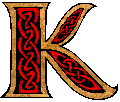 is for Kilsyth, a small town in central Scotland, about halfway between Glasgow and Stirling. Near the old Roman Antonine Wall, Kilsyth is situated on the main east-west route across the narrowest part of Scotland. It is also, according to many, the birthplace of modern curling.
is for Kilsyth, a small town in central Scotland, about halfway between Glasgow and Stirling. Near the old Roman Antonine Wall, Kilsyth is situated on the main east-west route across the narrowest part of Scotland. It is also, according to many, the birthplace of modern curling.
There are many claimed birthplaces of curling in Scotland. The earliest known curling stone, inscribed with the date 1511, was found at the bottom of a pond in Dublane, near Stirling. The earliest known written mention of a contest played on ice using stones comes from the records of Paisley Abbey, in Renfrewshire, dated 1541.
Kilsyth, however, does hold a credible claim to having organised the sport into something akin to the game we play today. The Colzium estate, just outside the town proper, boasts one of the earliest known man-made curling ponds, dating to the early eighteenth century, and the Kilsyth curling club, officially constituted in 1716 and still extant today, is considered the world's first formalised club.
<- Start at the beginning.
March 22, 2009
The ABCs of Curling - K
Labels:
ABCs of curling
Subscribe to:
Post Comments (Atom)







1 comments:
These much vaguer points are by far the more interesting ones for me on this journey down the pebbled ice.
You may be able to hear me utter, in my best (but still bad) Spock impersonation:
"Fascinating."
Post a Comment